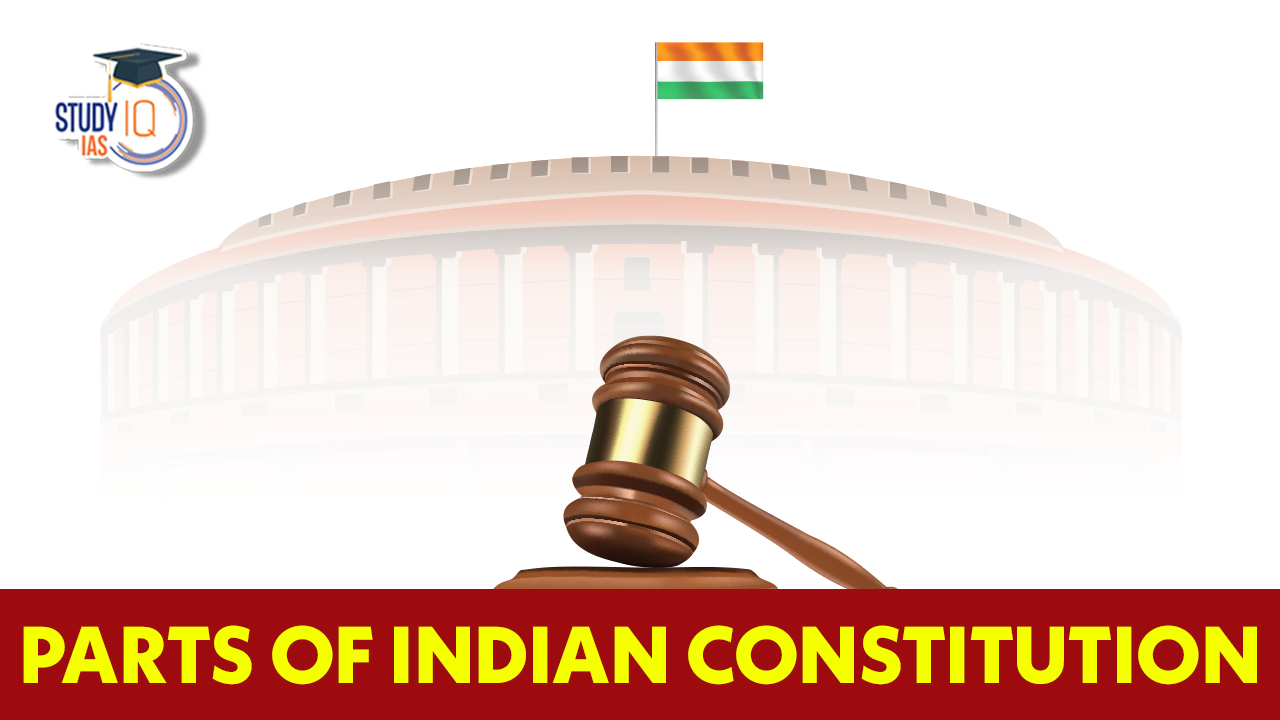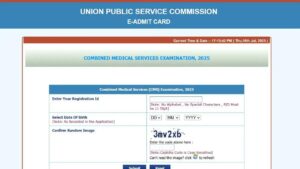Table of Contents
The Indian Constitution originally contained 395 Articles, 8 Schedules, and 22 Parts of Indian Constitution. Later, three parts were added as modifications, namely 9A Municipalities, 9B Co-operative societies, and 14A tribunals, bringing the total to 25. The Indian Constitution now consists of 448 Articles, 25 Parts, and 12 Schedules.
Schedules contain information that is not included in an Article or Part. It should be noted that anytime a new Article or Part is added to the Indian Constitution, it is done alphabetically (for example, Article 21 A) so that the structure of the Constitution is not disturbed. The following article provides a detailed information on all Parts of Indian Constitution.
Parts of Indian Constitution Overview
The constitution is all about the legal form of the document as well as the highest law of India. It primarily discusses in detail the many people in positions of authority, as well as the limitations on their power. The Indian constitution is the supreme form of Indian legislation. It defines all essential rights, powers, procedures, and principles, as well as the duties of the government and citizens. Its primary emphasis is on the supremacy of the constitution rather than the supremacy of the legislature. Check the Parts of Indian Constitution Overview below in the table:
| Parts of Indian Constitution Overview | |
| Particulars | Details |
| Constitution formed on | 26th November 1949 |
| Parts of Indian Constitution Originally | 22 Parts |
| Parts of Indian Constitution at Present | 25 Parts |
| New Parts added in Constitution |
|
List of Parts of Indian Constitution
The Indian Constitution is a written document that includes the supreme legislation of the land. The Constituent Assembly, which included Dr. B.R. Ambedkar, Rajendra Prasad, Jawaharlal Nehru, and others, created the constitution. It was formally adopted on January 26, 1950. The constitution is divided into sections that split the agenda into particular items. The Indian constitution is divided into 25 parts, learn more about the Parts of Indian Constitution listed below:
| Parts and Subject | Articles |
| Part I – The Union and its Territories | 1 – 4 |
| Part II – Citizenship | 5 -11 |
| Part III – Fundamental Rights | 12 – 35 |
| Part IV – Directive Principles of State Policy | 36 – 51 |
| Part IV A – Fundamental Duties | 51A |
| Part V – The Union | 52 – 151 |
| Part VI – The States | 152 – 237 |
| Part VII – The States in Part B of First Schedule | 238 [Repealed] |
| Part VIII – The Union Territories | 239 – 242 |
| Part IX – The Panchayats | 243 – 243O |
| Part IXA – The Municipalities | 243P – 243ZG |
| Part IXB – The Co-operative Societies | 243ZH – 243ZT |
| Part X – The Scheduled and Tribal Areas | 244 – 244A |
| Part XI – Relation between the Union and the States | 245 – 263 |
| Part XII – Finance, Property, Contracts and Suits | 264 – 300A |
| Part XIII – Trade, Commerce and Intercourse within the territory of India | 301 – 307 |
| Part XIV – Services Under the Union and the States | 308 – 323 |
| Part XIVA – Tribunals | 323A – 323B |
| Part XV – Elections | 324 – 329A |
| Part XVI – Special provisions relating to certain classes | 330 – 342 |
| Part XVII – Official language | 343 – 351 |
| Part XVIII – Emergency Provisions | 352 – 360 |
| Part XIX – Miscellaneous | 361 – 367 |
| Part XX – Amendment of the Constitution | 368 |
| Part XXI – Temporary, Transitional and Special Provisions | 369 – 392 |
| Part XXII – Short Title, Commencement, Authoritative Text in Hindi and Repeals | 393 – 395 |
Parts of Indian Constitution in Detail
All the 25 Parts of the Indian Constitution have been discussed here in detail. Check for the better understanding of the Parts of Indian Constitution below:
Part I : the Union and its territory
- It is covered under Article 1 to 4 of the Indian Constitution.
- India is referred to in the Constitution as a Union of States, indicating that its unity cannot be broken.
- The Indian Union cannot split in two.
- The Constitution specifies not only the structure of the Union Government but also the structure of the state governments.
- The country is divided into numerous regions known as states or union territories.
Part II : Citizenship
- Articles 5 to 11 of the Indian Constitution address citizenship under Part II.
- In contrast to Articles 9 to 11, which define how citizenship is obtained and lost, Articles 5 to 8 describe who was eligible for Indian citizenship at the time the Constitution was enacted.
Part III : Fundamental Rights
- A number of Fundamental Rights are guaranteed under Part III of the Indian Constitution (Articles 12 to 35), as well as remedies in the event that they are violated.
- The main justification for adding these rights in a democratic constitution is that people occasionally need to be protected from collective action by others who might not fully comprehend their desires and positions.
- The US Bill of Rights’ clauses have been heavily referenced and impacted by the fundamental rights guaranteed by the Indian Constitution.
Part IV : Directive Principles of State Policy
- The Directive Principles of State Policy (DPSP) are incorporated into Articles 36 to 51 of the Indian Constitution, however Article 37 clearly declares that these DPSP are not subject to legal action in a court of law.
- Due to the inherent inability of these principles to be upheld through legal channels and the potential inadequacy of the nation’s economic resources, they were declared non-justiciable in court.
Part IVA : Fundamental Duties
- The Constitution (Forty-second Amendment) Act of 1976 inserted Part IV-A based on the Swaran Singh Committee’s recommendation during the state of emergency.
- The Amendment changed the Constitution to include a new Part IV-A that only contained Article 51-A.
- The Indian Constitution stipulates 11 Fundamental Duties.
Part V : The Union
Union has been covered under Article 52 to 151. It can be divided into following:
- Union Executive (Article 52 – 78)
- Union Legislature (Articles 79-122)
- Union Judiciary (Articles 124-147)
Part VI : The States
- It has been covered under Article 153-237.
- The states can be discussed under three broadheads, which are provided below.
- The State Executive (Articles 153-167)
- The State Legislature (Articles 168-212)
- The State Judiciary (Articles 214-237)
Part VIII : The Union Territories
- The ultimate decision-making authority in matters involving the administration of union territories belongs to Parliament.
- The President will be responsible for overseeing the Union territory through a person he or she chooses as administrator, unless Parliament specifies otherwise.
- There is a unitary relationship between the Union Territories and the Center.
- They are directly managed and governed by the Centre.
- They lack autonomy, and their organizational structure isn’t conventional.
Part IX : The Panchayats
- According to Article 40 of the Constitution, the State shall make efforts to establish village panchayats and grant them the powers and authority that may be necessary to enable them to function as units of self-government.
- Panchayats, which are covered by the 73rd Amendment to the Constitution, are designed to enhance local self-government at the village, town, and city levels while also enabling collaboration between rural and urban areas.
Part IXA : The Municipalities
Urban self-government entities are defined under the Constitution (Seventy-fourth Amendment) Act of 1992 in terms of their organization, membership, authority, and duties.
Part IXB : Co-operative Societies
- One type of self-help group is a cooperative society.
- It is a crucial weapon for attaining the Preamble of the Indian Constitution’s vision of social and economic justice as well as safeguarding people from capitalist exploitation.
- The Constitution (Ninety-seventh Amendment) Act of 2011 added a new Part IX B to the Constitution after Part IX-A, which includes Articles 243 ZH through 243 ZT.
- Cooperative societies are the main topic of the new section.
Part X : The Scheduled and Tribal Areas
Article 244 specifies that, with the exception of Assam, Meghalaya, Tripura, and Mizoram, the Fifth Schedule applies to the administration and control of Scheduled Areas and Scheduled Tribes in all states, while the Sixth Schedule applies to the administration and control of Tribal Areas in those states.
Part XI : Relations between the Union and the States
Relations between the Union and the States is covered under Article 245 – 289. The relation between the Union and the states can be understood under three broad heads which are provided here under.
- Legislative relations (Article 245-255)
- Administrative relations (Article 256-263)
- Financial relations (Articles 264-289)
Part XII : Finance, Property, Contracts, and Suits
The transfer of the properties, assets, rights, liabilities, and obligations of the Indian states is governed under Article 295. According to Article 298 the following duties should be within the purview of the executive power of the Union or States:
- To engage in any type of commerce or business,
- To purchase, hold, or sell the property,
- To enter into contracts for any purpose.
Part XIII : Trade, Commerce and Intercourse within the Territory of India
- The Indian Constitution’s Part XIII, Articles 301 to 307, guarantees freedom of trade, commerce, and sexual activity.
- While Articles 302 to 305 list the trade prohibitions, Article 301 specifies the general principles of trade and commerce.
- The Australian Constitution served as a model for these provisions.
Part XIV : Services under the Union and the States
- Articles 308 through 323 cover topics pertaining to the services provided by the Union and the states.
- While Articles 315 to 323 deal with Public Service Commissions for the Union and states, Articles 308 to 313 deal with the hiring, firing, working conditions, and constitutional protection of public employees.
Part XIVA : Tribunals
A tribunal is a quasi-judicial organization created to deal with problems like resolving administrative or tax-related disputes.
Its duties range from adjudicating disputes to determining the rights of conflicting parties to making administrative judgments and evaluating administrative decisions, among other things.
The 42nd Amendment Act of 1976 to the Indian Constitution established tribunals, which were not included in the original Constitution.
- Article 323-A addresses Administrative Tribunals.
- Article 323-B addresses other tribunals.
Part XV : Elections
The topics covered in Part XV (Articles 324 to 329) relate to elections. According to Article 324 (1) of the Constitution, the Election Commission has extensive authority, however these powers cannot be used in ways that go against the law or current regulations.
Part XVI : Special provisions relating to certain classes
- Special provisions pertaining to specific classes are covered in Part XVI. Articles 330 to 342 provide special safeguards to safeguard the rights of Anglo-Indians, Backward Classes, Scheduled Castes, and Scheduled Tribes.
- The reservation of seats in the Lok Sabha and State Assemblies are covered in Articles 330 and 332, respectively.
- According to Article 330, seats in the Lok Sabha are reserved for members of Scheduled Castes and Scheduled Tribes.
- The entire population of such castes and tribes shall determine the number of seats allotted for them in any State or Union territory.
Part XVII : Official Language
- The Republic of India’s official language is outlined in Part XVII of the Indian Constitution (Articles 343 to 351).
- The primary guidelines for determining the official language of the Union are contained in Articles 343 and 344 of the Indian Constitution.
- The Constitution’s 8th Schedule lists the official languages of India.
Part XVIII : Emergency Provisions
The Emergency Provision in India is covered in Part XVIII of the constitution. In India, the federal government is given the power to become a unitary government if the situation calls for it thanks to the Constitution’s emergency provisions. The Indian Constitution recognizes three different categories of emergencies:
Part XIX : Miscellaneous
Part XIX of the Indian Constitution contains provisions concerning the following topics:
- President and governors’ protection.
- Courts are barred from interfering in disputes resulting from certain treaties, accords, and so on.
- Recognition of Indian state rulers and privy purses is abolished.
- Special rules apply to major ports and airports.
- The consequence of failing to comply with or carry out Union directives.
- Definitions outlined in Article 366.
- Interpretation of the constitutional provisions.
Part XX : Amendment to the Constitution
- Part XX is concerned with Amendment of the Constitutional of India.
- The designers of the Constitution of India envisioned a mechanism for amending the Constitution that is neither too rigid nor too flexible.
- Article 368 particularly addresses amendments, while other provisions of the Constitution provide amendments through the ordinary parliamentary system.
Part XXI : Temporary, Transitional and Special Provisions
- Part XXI of the Indian Constitution contains legislation pertaining to the country’s Constitution and the union of states that comprise it.
- This section of the Constitution is made up of articles on Temporary, Transitional, and Special Provisions.
- The purpose of Articles 371 to 371-J of Part XXI is to meet the aspirations of the people of backward regions of the states, to protect the tribal people’s cultural and economic interests, to deal with the disturbed law and order situation in some parts of the states, and to protect the interests of the local people of the states.
Part XXII : Short title, commencement, authoritative text in Hindi and repeals
Part XXII is a compilation of laws that includes articles on the short title, beginning date, authoritative text in Hindi, and repeals.
Parts of Indian Constitution UPSC
The constitution explains the legal structure of a text and the supreme law applicable to India. It basically provides a thorough explanation of the various authorities and how their power is constrained. The highest authority on Indian law is the Indian constitution. It outlines all of the core tasks of the government and the people, as well as all of the fundamental rights, authority, and procedures. All the Parts of Indian Constitution have been discussed in details in this article.


 UPSC CMS Admit Card 2025 Out: Download L...
UPSC CMS Admit Card 2025 Out: Download L...
 UPSC Study Material for Prelims & Ma...
UPSC Study Material for Prelims & Ma...
 NATO Countries List 2025, Members, Funct...
NATO Countries List 2025, Members, Funct...





















